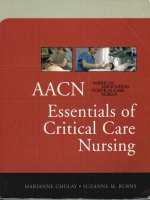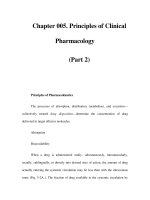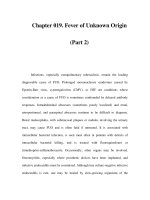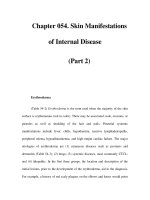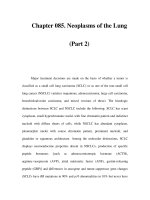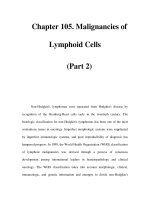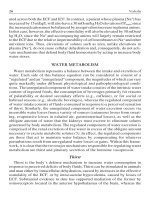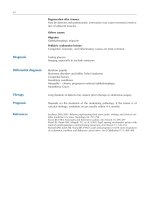CURRENT ESSENTIALS OF CRITICAL CARE - PART 2 ppt
Bạn đang xem bản rút gọn của tài liệu. Xem và tải ngay bản đầy đủ của tài liệu tại đây (161.34 KB, 32 trang )
Pulse Oximetry
■
Essential Concepts
•
Finger, ear, or other cutaneous probe measures transmission or
reflectance of red and infrared light through tissue
•
Pulsatile absorbance (“beat-to-beat”) determines percentage of
oxyhemoglobin in blood
•
Oxyhemoglobin, carboxyhemoglobin, and methemoglobin read
as “oxyhemoglobin”
•
Pulsatile waveform essential for calculation; low perfusion, hy-
potension, arterial disease, motion artifacts interfere with mea-
surement
•
Correlates well with arterial blood O
2
saturation
■
Essentials of Management
•
Use for routine monitoring of patients in ICU and during en-
doscopy, bronchoscopy, minor surgery, suctioning, sleep apnea
episodes, bronchodilator therapy
•
Use to adjust supplemental oxygen therapy, including mechan-
ical ventilation
•
Provides estimate of arterial oxygenation; still need arterial
blood gases for Pa
CO
2
and pH.
•
Do not use to exclude significant carboxyhemoglobinemia (eg,
after smoke inhalation)
•
May not be accurate during cardiopulmonary resuscitation
•
Attach to ear lobe or finger according to manufacturer’s in-
structions
•
Check for pulsatile waveform on monitor (if provided)
•
If waveform is poor or pulse oximeter does not provide an ad-
equate reading, try other locations
■
Pearl
Very high methemoglobin levels have the peculiar effect of causing
the pulse oximeter to read 75% regardless of concentration or oxy-
genation.
Reference
Lee WW et al: The accuracy of pulse oximetry in the emergency department.
Am J Emerg Med 2000;18:427. [PMID: 10919532]
20 Current Essentials of Critical Care
5065_e01_p1-22 8/17/04 10:23 AM Page 20
Upper GI Bleeding, Prevention
■
Essential Concepts
•
10–25% incidence of shallow, stress-induced ulceration of gas-
tric mucosa with subclinical or clinically important upper GI
bleeding in critically ill patients; associated with poor outcome,
increased mortality
•
May have clinical bleeding or persistent unexplained fall in he-
moglobin
•
Risk factors: mechanical ventilation, coagulopathy, thrombocy-
topenia, renal failure, burns, postsurgical, possibly lack of en-
teral feeding, aspirin; may be due to cytokine-mediated decrease
in upper GI mucosal resistance to gastric acid, H pylori, multi-
organ system failure, impaired hemostasis, medications, de-
creased mucosal blood flow
■
Essentials of Management
•
Give prophylactic therapy for all patients receiving mechanical
ventilation, with thrombocytopenia, qualitative platelet dys-
function, coagulopathy, significant burns, renal or liver failure
•
Consider in all patients in ICU, especially if hypotension, low
cardiac output, inability to feed enterally
•
Sucralfate, a nonantacid, possibly associated with less nosoco-
mial pneumonia; may be less effective
•
For antacid therapies, best results with pH Ͼ 4.0 (measurement
of pH not clinically indicated)
•
Ranitidine, 150 mg IV per day, continuous infusion or every 8
hours, or famotidine 20 mg IV every 12 hours; adjust for renal
insufficiency.
•
Alternative: pantoprazole 40 mg IV daily for 5–7 days, then
switch to oral pantoprazole or omeprazole
■
Pearl
Patients with highest risk for stress-related upper GI bleeding are
those receiving mechanical ventilation and those with disorders tend-
ing to lead to bleeding.
Reference
Steinberg KP: Stress-related mucosal disease in the critically ill patient: risk
factors and strategies to prevent stress-related bleeding in the intensive care
unit. Crit Care Med 2002;30(6 Suppl):S362. [PMID: 1207266]
Chapter 1 Monitoring & Support 21
5065_e01_p1-22 8/17/04 10:23 AM Page 21
This page intentionally left blank
23
2
ICU Supportive Care for Specific
Medical Problems
Burn Patients 25
Chronic Renal Failure Patients 26
Pregnant Patients 27
Solid Organ Transplant Recipients 28
5065_e02_p23-28 8/17/04 10:24 AM Page 23
This page intentionally left blank
Burn Patients
■
Essential Concepts
•
Assess burn depth: first-degree burns red, dry, painful; second-
degree burns red, wet, very painful; third-degree burns leathery,
dry, insensate
•
Assess extent of total body surface area (TBSA) involved: in
adults each body segment assigned 9%: head and neck; anterior
chest; posterior chest; anterior abdomen; posterior abdomen in-
cluding buttocks; each upper extremity; each thigh; each leg and
foot; genitals assigned 1%
•
Attention to surrounding circumstances important to identify po-
tential toxic exposures; evaluate for associated injuries: neuro-
logic and musculoskeletal examinations
•
Patients sustaining serious burns should be transferred to burn
center based on American Burn Association criteria: any burn
Ͼ 10% TBSA in patients Ͻ 10 or Ͼ 50 years of age; burns in-
volving Ͼ 20% TBSA; second- and third-degree burns involv-
ing face, hands, feet, genitalia, perineum, major joints; third-
degree burns Ͼ 5% TBSA; significant electrical, chemical, in-
halational burns
■
Essentials of Management
•
Maintenance of cardiopulmonary function including intubation
and mechanical ventilation if airway compromised or breathing
appears insufficient
•
Immediate fluid resuscitation with half estimated needs admin-
istered within first 8 hours; use formulas based on body size,
depth, extent of burn to estimate fluid needs; most recommend
avoiding colloid during first 24 hours and using crystalloid so-
lutions
•
Escharotomy may be necessary to prevent secondary ischemic
tissue necrosis and to relieve elevated tissue pressures
•
Topical antimicrobial therapy with mafenide, silver sulfadi-
azine, silver nitrate may decrease incidence of invasive infec-
tion
•
Increased metabolic rates in postburn period increase caloric and
protein needs; require early nutritional support
■
Pearl
Burns involving more than 25% of the total body surface area require
intravenous fluid resuscitation because ileus precludes oral resusci-
tation.
Reference
Sheridan RL: Burns. Crit Care Med 2002 Nov;30:S500. [PMID: 12528792]
Chapter 2 ICU Supportive Care for Specific Medical Problems 25
5065_e02_p23-28 8/17/04 10:24 AM Page 25
Chronic Renal Failure Patients
■
Essential Concepts
•
Elevated BUN and creatinine present over weeks to years
•
Malaise, nausea, hiccups, pruritis, confusion, metallic taste, im-
potence
•
Hypertension, fluid overload, uremic fetor, pericardial friction
rub, asterixis, sallow complexion
•
Anemia, platelet dysfunction, metabolic acidosis, hyperkalemia
•
Hyperphosphatemia and hypocalcemia lead to renal osteodys-
trophy
•
Renal imaging reveals bilateral small echogenic kidneys
■
Essentials of Management
•
Renal biopsy not helpful in identifying underlying cause
•
Sodium and fluid restriction; blood pressure control
•
Nutritional support: protein restriction (unless receiving he-
modialysis), reduced dietary potassium and phosphorus
•
Avoid hypotension, excessive diuresis
•
Avoid nephrotoxic agents: aminoglycosides, NSAIDs, contrast
agents
•
Monitor medications interfering with creatinine clearance: ACE
inhibitors, histamine blockers, trimethoprim
•
Adjust dosages of medications eliminated by kidneys
•
Avoid excessive magnesium-containing compounds: antacids,
laxatives
•
Administer oral phosphate binders
•
Correct metabolic acidosis, especially if limited ventilatory ca-
pacity
•
Recombinant erythropoietin with or without iron for anemia
•
Monitor for cardiac tamponade when pericarditis present
•
Urgent hemodialysis if severe acidosis, hyperkalemia with ECG
changes, fluid overload, symptomatic uremia
•
Kidney transplantation
■
Pearl
While severe hypocalcemia is a common laboratory finding in chronic
renal failure, clinical manifestations of tetany are rarely seen because
ionized calcium is favorably increased in the setting of acidemia that
accompanies chronic renal impairment.
Reference
Yu HT: Progression of chronic renal failure. Arch Intern Med 2003;163:1417.
[PMID: 12824091]
26 Current Essentials of Critical Care
5065_e02_p23-28 8/17/04 10:24 AM Page 26
Pregnant Patients
■
Essential Concepts
•
Altered maternal physiology, presence of fetus, diseases spe-
cific to pregnancy make management challenging
•
Organ systems adapt to optimize fetal and maternal outcome
•
Cardiovascular system: electrical axis changes with lateral de-
viation of apex; cardiac output, heart rate, stroke volume in-
crease; reduced peripheral vascular resistance leads to decreased
systemic blood pressure
•
Respiratory system: minute ventilation increases in excess of
need for oxygen delivery; “hyperventilation of pregnancy” hor-
monally mediated and results in decreased Pa
CO
2
(28 to 32 mm
Hg); compensatory bicarbonate loss maintains normal pH
•
Hematologic system: disproportionate plasma volume increase
compared to red cell mass leads to “dilutional anemia”; in-
creased thromboembolic risk due to alterations in clotting fac-
tors, venous stasis, vessel wall injury
•
Laboratory changes: creatinine decreases while creatinine clear-
ance increases; elevated alkaline phosphatase related to placen-
tal production
■
Essentials of Management
•
Position: avoid supine position after 20 weeks gestation; right
lateral decubitus or Fowler position (head of bed elevated) pre-
ferred for immobilized patient
•
Monitoring: fetal heart tones should be part of vital signs; con-
tinuous fetal monitoring after 23 weeks’ gestation if maternal
condition affects cardiopulmonary function
•
Thromboembolism prophylaxis: unfractionated or low molecu-
lar weight heparin if not contraindicated; venous compression
stockings of lesser benefit
•
Nutrition: address early as pregnant women more susceptible to
starvation ketosis
•
Imaging studies: ionizing radiation known to be teratogenic;
limit radiographs appropriately but do not withhold if results
may lead to therapeutic intervention
■
Pearl
Although care of the mother is the primary concern in most circum-
stances, attention must also be paid to fetal health and well-being.
Reference
Naylor DF et al: Critical care obstetrics and gynecology. Crit Care Clin
2003;19:127. [PMID: 12688581]
Chapter 2 ICU Supportive Care for Specific Medical Problems 27
5065_e02_p23-28 8/17/04 10:24 AM Page 27
Solid Organ Transplant Recipients
■
Essential Concepts
•
High risk for complications related to transplanted organ,
anatomical disturbances, immunosuppressive therapies
•
Graft failure and chronic rejection major concern but infections
leading cause of death; organism depends on time elapsed since
transplantation: first month bacterial processes (wound, urine,
lung); 1 to 6 months viral (CMV, EBV) and opportunistic (PCP,
Aspergillus); beyond 6 months resemble general community
•
Classic signs of infection such as fever often masked by im-
munosuppression
•
Pancreatitis and hepatotoxicity due to viral infection or med-
ications
•
Posttransplant malignancies: lymphoproliferative disorder
(PTLD), Kaposi sarcoma
•
Steroid-induced diabetes, avascular necrosis, osteoporosis
•
Hyperlipidemia and accelerated atherosclerosis
•
Adrenal axis suppression
•
Medication interactions and potential toxicity: metabolism of
immunosuppressive agents often affected by antibiotics, anti-
fungal agents, antituberculosis drugs, anticonvulsants, antacids,
histamine blockers, calcium channel blockers
■
Essentials of Management
•
Continue prophylactic antibiotics and antiviral medications
•
Aggressively treat suspected or identified infections
•
If life-threatening infection present, discontinue immunosup-
pressive regimen despite risk of graft rejection
•
“Stress” dose steroids required in acutely ill patient recently on
corticosteroids as part of immunosuppression regimen
•
Evaluate for drug–drug interactions and monitor for toxicity
when adding new medications
•
Biopsy of transplanted organ required for diagnosis of rejection;
may require additional immunosuppressive agents
•
If PTLD suspected, reduction of immunosuppression indicated
combined with acyclovir or ganciclovir
■
Pearl
Graft-versus-host disease, although most commonly associated with
bone marrow transplantation, can also be seen in intestinal and mul-
tivisceral transplantations.
Reference
Dunn DL: Hazardous crossing: immunosuppression and nosocomial infections
in solid organ transplant recipients. Surg Infect 2001;2:103. [PMID:
12594865]
28 Current Essentials of Critical Care
5065_e02_p23-28 8/17/04 10:24 AM Page 28
29
3
Ethical Issues
Brain Death 31
Do-Not-Resuscitate Orders (DNR) 32
Medical Ethics 33
Medicolegal Principles 34
Withholding & Withdrawing Care 35
5065_e03_p29-36 8/17/04 10:24 AM Page 29
This page intentionally left blank
Brain Death
■
Essentials of Diagnosis
•
Irreversible cessation of brain function, cortical and brain stem
•
Brain stem: no oculocephalic reflex, pupils fixed, lack of mo-
tor reflexes, absence of spontaneous respiration
•
No spontaneous breathing for 10 minutes after discontinuing
mechanical ventilation (patient given 100% O
2
to breathe)
and/or Pa
CO
2
Ͼ 55 mm Hg
•
Local or institutional policy may require determination by neu-
rologist or neurosurgeon, need more than one examiner, require
two examinations conducted at a defined interval, or mandate
electroencephalogram (EEG)
■
Differential Diagnosis
•
Hypothermia
•
Presence of sedative-hypnotic drugs (benzodiazepines, barbitu-
rates, etc.).
•
Severe vegetative state (some brain stem function)
■
Treatment
•
Determine if brain death is present by institutional or local cri-
teria
•
According to institutional procedure, determine and act accord-
ingly if patient is potential organ donor
•
If brain death declaration is made, time of death is time deter-
mination made
•
Remove life support therapy after declaration of death, except
for organ donation
■
Pearl
When testing for apnea, give 100% oxygen through the endotracheal
tube to avoid hypoxic injury, then observe for at least 10 minutes or
until the Pa
CO
2
rises above 60 mm Hg.
Reference
Wijdicks EF: The diagnosis of brain death. N Engl J Med 2001;344:1215.
[PMID: 11309637]
Chapter 3 Ethical Issues 31
5065_e03_p29-36 8/17/04 10:24 AM Page 31
Do-Not-Resuscitate Orders (DNR)
■
Essential Concepts
•
The Do-Not-Resuscitate (Do-Not-Attempt Resuscitation; DNR)
order stops automatic cardiopulmonary resuscitation
•
Only applies to patient at time of cardiopulmonary arrest; with-
holding or withdrawing other care separate decisions
•
DNR extends patient’s autonomy to make informed choice,
while knowing consequences of decision
•
In multiple organ failure or critical illness, cardiopulmonary re-
suscitation Ͻ 10% likelihood of success and very poor outcome
(Ͻ5% normal function)
•
Resuscitation of acute, reversible, witnessed arrest often more
successful
■
Essentials of Management
•
Consider DNR discussion with patient or other decision maker
for all critically ill patients in ICU
•
Determine if DNR already addressed in advance directives
•
Assure patient and family that DNR does not discontinue com-
fort measures and pain control
•
Follow institution’s DNR policy for documentation; include
time of discussion, persons who participated, level of under-
standing of patient, other decisions about patient care
•
If disagreement about DNR, make efforts to clarify misunder-
standings, misconceptions, concerns
•
DNR may be temporarily suspended for general anesthesia or
cardiac catheterization, during which there is increased risk of
cardiopulmonary arrest
■
Pearl
Only about 30% of patients with likely very poor outcome have DNR
orders.
Reference
Burns JP et al: Do-not-resuscitate order after 25 years. Crit Care Med
2003;31:1543. [PMID: 12771631]
32 Current Essentials of Critical Care
5065_e03_p29-36 8/17/04 10:24 AM Page 32
Medical Ethics
■
Essential Concepts
•
Ethical decisions based on four basic principles
•
Autonomy: Patient has right to make informed decisions and re-
fusals, if has capacity to understand consequences of decisions;
capacity means understanding consequences of decision
•
Beneficence: Care must achieve good not harm; goals of med-
icine are saving life, prolonging life, relieving suffering, curing
disease
•
Nonmaleficence: Avoid harm while meeting other goals and
principles; at times, may conflict with beneficence
•
Justice: Treat fairly in relationship to others; allocate resources
where likely to do most good
■
Essentials of Management
•
Let patients or other decision makers make autonomous deci-
sions but only after giving sufficient information and confirm-
ing understanding
•
Care must focus on achieving goals of medicine
•
All options and decisions must weigh benefits against risks for
each diagnostic or therapeutic intervention
•
Physicians responsible to individual patient; may conflict at
times with responsibility to community (eg, costs of care, lim-
ited resources)
•
Common conflicts: Patient has autonomy to make informed
choices, but physicians must not allow them to harm themselves.
When striving to relieve suffering (pain), analgesia may shorten
life. Patients have right to make decisions, even if they conflict
with family members
■
Pearl
Designated surrogate decision makers often do not make same deci-
sion as the patient would; prior discussion and communication greatly
improve agreement.
Reference
Henig NR et al: Biomedical ethics and the withdrawal of advanced life sup-
port. Annu Rev Med 2001;52:79. [PMID: 11160769]
Chapter 3 Ethical Issues 33
5065_e03_p29-36 8/17/04 10:24 AM Page 33
Medicolegal Principles
■
Essential Concepts
•
A patient with capacity to understand consequences may choose
or refuse medical care offered
•
Capacity to make medical decisions may be present even with-
out capacity to make other decisions (e.g., financial)
•
Informed consent: Patient consents after understanding benefits,
risks, and their likelihood for a test or treatment
•
Informed denial (refusal): Patient declines a test or procedure,
but only after demonstrating understanding the consequences of
refusal
•
When patient lacks capacity, use surrogate decision maker, of-
ten, but not always, a family member; ideally chosen in advance
by patient
•
Surrogate must decide based on patient’s likely choice, either
explicit or implicit
•
In absence of surrogate, may need to make a “best interests” de-
cision—what would a reasonable person choose?
■
Essentials of Management
•
Evaluate capacity as patient’s ability to understand conse-
quences of individual medical choices presented
•
For informed consent, explain likely events, consequences, re-
sults; very rare events need not be mentioned
•
Always make a judgment about the patient’s level of under-
standing, whether consenting to or declining offered treatment
•
If a surrogate does not know patient’s wishes, make a “best in-
terest” decision weighing benefits and burdens of treatment to
patient
•
In absence of any surrogate who knows patient’s wishes, physi-
cians may make decisions according to local policy, including
forgoing of treatment.
■
Pearl
Forgoing treatment in the absence of clear-cut direct knowledge that
this is the patient’s wish can still be undertaken.
Reference
Meisel A et al: Seven legal barriers to end-of-life care: myths, realities, and
grains of truth. JAMA 2000;284:2495. [PMID: 11074780]
34 Current Essentials of Critical Care
5065_e03_p29-36 8/17/04 10:24 AM Page 34
Withholding & Withdrawing Care
■
Essential Concepts
•
Any medical care may be withdrawn or withheld, not just ex-
traordinary measures
•
Under no obligation to provide care that does not meet a goal
of medicine—prolonging life, relieving suffering, or curing dis-
ease
•
Patient with capacity to make decisions can ask that care be
withdrawn or withheld
•
Advance directive may designate withholding of treatment
•
Not helpful to distinguish ordinary (feeding, hydration, pain
medication) from extraordinary care (mechanical ventilation,
major surgery, blood transfusions)
•
Extensive discussions with patient, family, and staff essential
for decisions regarding forgoing care
•
Always maintain patient comfort, dignity, hygiene
■
Essentials of Management
•
Patient or surrogate decision maker asks that care be withheld
or withdrawn
•
Physician believes current or proposed care not indicated be-
cause of very low likelihood of benefit
•
Risks of current or proposed care outweigh potential benefit;
such care conflicts with prolonging life or relieving suffering
•
If forgoing of treatment decided, follow institutional policy for
documenting in medical record; include date and time of dis-
cussion, persons who participated (patient, family members, sur-
rogate decision makers), level of understanding of patient
•
Involve ICU staff in decision-making process; inform of deci-
sions
•
Continue comfort measures, including adequate analgesia and
sedation
•
Reassess patient’s wishes periodically
■
Pearl
A patient or surrogate may be unaware of the option to withhold or
withdraw care.
Reference
Nyman DJ Sprung CL: End-of-life decision making in the intensive care unit.
Intensive Care Med 2000;26:1414. [PMID: 11126250]
Chapter 3 Ethical Issues 35
5065_e03_p29-36 8/17/04 10:24 AM Page 35
This page intentionally left blank
37
4
Bleeding & Transfusions
Bleeding in the Critically Ill Patient 39
Coagulopathy, Acquired 40
Coagulopathy, Inherited 41
Heparin-Induced Thrombocytopenia (HIT) 42
Plasma Transfusions 43
Qualitative Platelet Dysfunction 44
Thrombocytopenia 45
Transfusion of Red Blood Cells 46
Transfusion Reactions 47
Warfarin Overdose 48
Warfarin Skin Necrosis 49
5065_e04_p37-50 8/17/04 10:25 AM Page 37
This page intentionally left blank
Bleeding in the Critically Ill Patient
■
Essentials of Diagnosis
•
Spontaneous bleeding or bleeding from invasive procedures due
to one or more defects in hemostasis
•
Normal hemostasis needs intact vascular endothelium, coagula-
tion factors, adequate platelet number and function
•
Thrombocytopenia or platelet dysfunction: ecchymoses and mu-
cosal bleeding, posttraumatic or surgical bleeding
•
Acquired or inherited coagulopathies: spontaneous hem-
arthroses or soft tissue hematomas
•
Severe coagulopathy, thrombocytopenia, or disseminated in-
travascular coagulation (DIC): generalized bleeding, especially
new acute onset
•
Excessive warfarin: soft tissue hematoma
■
Differential Diagnosis
•
Abnormal prothrombin time (PT) only: vitamin K deficiency,
liver disease, warfarin, specific inhibitor
•
Abnormal activated partial thromboplastin time (aPTT) only: in-
herited coagulopathy, heparin, lupus anticoagulant, specific in-
hibitor
•
Both aPTT and PT abnormal: vitamin K deficiency, DIC, liver
disease, heparin or warfarin
•
Abnormal aPTT, PTT, platelet count: DIC (microangiopathic
hemolytic anemia, low fibrinogen, elevated fibrin degradation
products, elevated D-dimer)
•
Screening tests normal: platelet dysfunction, endothelial dam-
age, factor XIII deficiency
■
Treatment
•
Assess severity and acuity of bleeding; estimate rapidity of
blood loss; treat if active or anticipated bleeding, invasive pro-
cedures necessary
•
Management depends on etiology; vitamin K, fresh frozen
plasma, cryoprecipitate, platelet transfusions, stopping antico-
agulants
■
Pearl
Consider acute acquired dysfunction of platelets if unexplained bleed-
ing with no previous history; may be due to renal failure, drugs such
as aspirin, NSAIDs, or platelet inhibitors.
Reference
DeSancho MT et al: Bleeding and thrombotic complications in critically ill pa-
tients with cancer. Crit Care Clin 2001;17:599. [PMID: 11525050]
Chapter 4 Bleeding & Transfusions 39
5065_e04_p37-50 8/17/04 10:25 AM Page 39
Coagulopathy, Acquired
■
Essentials of Diagnosis
•
Excessive or prolonged bleeding from punctures, incisions, GI
tract, mucosal membranes, joints, retroperitoneal space, other
sites
•
Abnormal coagulation time (prothrombin time [PT] or activated
partial thromboplastin time [aPTT]) in absence of inherited co-
agulopathy
•
Causes: warfarin, heparin administration; liver disease; vitamin
K deficiency (malnutrition, antibiotics, poor intake); dissemi-
nated intravascular coagulation (sepsis, hypotension, release of
bone marrow thromboplastins, liver injury, abruptio placenta,
amniotic fluid embolism), trauma (fat embolism, brain injury);
acquired circulating anticoagulant (antibody to coagulation
factor)
■
Differential Diagnosis
•
Inherited coagulopathy
•
Thrombocytopenia or qualitative platelet disorder, vitamin C de-
ficiency
•
Abnormal aPTT without increased risk of bleeding (lupus anti-
coagulant)
■
Treatment
•
Establish etiology
•
Treat if active bleeding, high risk for bleeding, anticipated pro-
cedure (lumbar puncture, central venous catheter, surgery)
•
Vitamin K, 1–10 mg orally or subcutaneously, if vitamin K de-
ficiency suspected
•
Replace factors if moderate to severe bleeding; fresh frozen
plasma (FFP) contains factors absent in liver disease, vitamin
K deficiency, warfarin treatment, DIC; give FFP equal to 50%
of plasma volume (20 mL/kg ideal body weight); one unit FFP
approximately 250–300 mL, so give 4–6 units FFP over 6–12
hours
■
Pearl
Many antibiotics destroy enteric bacteria, which produce vitamin K;
give weekly vitamin K to ICU patients who are receiving antibiotics.
Reference
Teitel JM: Clinical approach to the patient with unexpected bleeding. Clin Lab
Haematol 2000;22 (1 Suppl):9. [PMID: 11251652]
40 Current Essentials of Critical Care
5065_e04_p37-50 8/17/04 10:25 AM Page 40
Coagulopathy, Inherited
■
Essentials of Diagnosis
•
Excessive or prolonged bleeding from punctures, incisions, GI
tract, mucosal membranes, joints, retroperitoneal space, other
sites
•
History of lifelong abnormal bleeding or family history of bleed-
ing disorders
•
Abnormally prolonged coagulation time (prothrombin time [PT]
or activated partial thromboplastin time [aPTT])
•
Common: von Willebrand disease (autosomal dominant defi-
ciency of von Willebrand factor with qualitative platelet dys-
function and prolonged aPTT due to factor VIII deficiency); he-
mophilia A (sex-linked, variably dysfunctional factor VIII);
hemophilia B (sex-linked deficiency of active factor IX).
•
Rare: deficiency of factors II, V, VII, X, XI, XIII, fibrinogen
•
Inheritance of gene coding abnormal coagulation factor or in-
sufficient production of a factor; X-linked or autosomal
■
Differential Diagnosis
•
Acquired coagulopathy
•
Thrombocytopenia or qualitative platelet disorder, vitamin C de-
ficiency
•
Abnormal aPTT without risk of bleeding (lupus anticoagulant)
■
Treatment
•
Establish etiology
•
Treat if active bleeding, high risk for bleeding, anticipated in-
vasive procedure (lumbar puncture, central venous catheter, sur-
gery)
•
von Willebrand disease: desmopressin (intravenous or in-
tranasal), cryoprecipitate
•
VIII deficiency: desmopressin for mild bleeding, purified or re-
combinant factor VIII
•
IX deficiency: Purified or recombinant factor IX
•
Fresh frozen plasma contains factors VIII, IX, most other fac-
tors, but should not be used unless others not available
■
Pearl
A woman with a hereditary coagulopathy almost always has von Wille-
brand disease.
Reference
Bolton-Maggs PH et al: Haemophilias A and B. Lancet 2003;361:1801. [PMID:
12781551]
Chapter 4 Bleeding & Transfusions 41
5065_e04_p37-50 8/17/04 10:25 AM Page 41
Heparin-Induced Thrombocytopenia (HIT)
■
Essentials of Diagnosis
•
Unexplained arterial or venous thrombosis, pulmonary em-
bolism, stroke, coronary occlusion, upper extremity DVT, with
fall in platelet count 4–14 days after starting heparin
•
Occurs with both therapeutic and prophylactic heparin, includ-
ing heparin flushing of catheters; may occur after heparin
stopped
•
Type I: slight fall in platelet count in 10–20% with unfraction-
ated heparin; nonimmune mediated, no clinical consequence,
earlier onset
•
Type II: 1% given unfractionated heparin, 0.3% low molecular
weight heparin, severe immune-mediated, associated with
thrombosis (often arterial), later onset (unless due to re-expo-
sure to heparin)
•
In type II, heparin-platelet factor 4 complex triggers antibody;
antibody-antigen complex binds to platelet surface causing ag-
gregation and platelet-rich clots; no risk of bleeding from throm-
bocytopenia (platelet count usually Ͼ 20,000)
•
Suspect in all patients with thrombocytopenia receiving heparin;
especially if rapid return of platelets after heparin stopped
■
Differential Diagnosis
•
Other causes of thrombocytopenia
•
Warfarin skin necrosis
•
Other thrombotic states, including malignancies, protein C or S
deficiency
■
Treatment
•
Stop all heparin: therapeutic, prophylactic, flushes
•
Use direct thrombin inhibitor (lepirudin or argatroban) for pa-
tients who continue to need anticoagulation, then warfarin; avoid
starting warfarin until platelet count Ͼ 100,000/L (may con-
tribute to hypercoagulable state)
•
Avoid future exposure to heparin
■
Pearl
Even small amounts of heparin can cause HIT, even heparin being
given to keep intravenous catheters from clotting.
Reference
Walenga JM et al: Heparin-induced thrombocytopenia, paradoxical throm-
boembolism, and other adverse effects of heparin-type therapy. Hematol On-
col Clin North Am 2003;17:259. [PMID: 12627671]
42 Current Essentials of Critical Care
5065_e04_p37-50 8/17/04 10:25 AM Page 42
Plasma Transfusions
■
Essential Concepts
•
Fresh frozen plasma (FFP) replaces coagulation factors in ac-
quired or inherited coagulopathy (liver disease, vitamin K defi-
ciency, DIC, warfarin therapy, hemophilia A or B, other inher-
ited coagulopathies; antithrombin deficiency); also for plasma
exchange therapy
•
Cryoprecipitate replaces fibrinogen, factor VIII; cryoprecipitate-
poor plasma useful for TTP/HUS
•
Plasma transfusion not indicated for volume expansion or treat-
ment of hypovolemic shock, hypoalbuminemia
■
Essentials of Management
•
Treat underlying disorder
•
Assess need for FFP: active bleeding, anticipated bleeding from
invasive procedure, severe coagulopathy, effect of alternative
therapy (vitamin K), response to discontinuing warfarin
•
FFP requirement for coagulopathy based on increasing coagu-
lation factors Ͼ 50% of normal; assume patient has 0% factors
to start
•
Give volume of FFP equal to 50% of plasma volume (20 mL/kg
ideal body weight); each FFP unit approximately 250–300 mL;
therefore, provide 4–6 units FFP over 6–12 hours, depending
on patient tolerance to volume replacement and urgency of
bleeding
•
Coagulation factors effective in circulation 4–24 hours, de-
pending on factor
•
For TTP/HUS, use cryoprecipitate-free FFP for TTP/HUS dur-
ing plasmapheresis; to replace fibrinogen in DIC and hypofib-
rinogenemia, use cryoprecipitate
•
Complications of plasma therapy: volume overload, infection
■
Pearl
In patients with severe liver disease, FFP transfusions will almost
never completely “correct” the coagulopathy; avoid fluid overload by
limiting total transfused.
Reference
Hellstern P et al: Practical guidelines for the clinical use of plasma. Thromb
Res 2002;107 (1 Suppl):S53. [PMID: 12379294]
Chapter 4 Bleeding & Transfusions 43
5065_e04_p37-50 8/17/04 10:25 AM Page 43
Qualitative Platelet Dysfunction
■
Essentials of Diagnosis
•
Mucosal bleeding, ecchymoses, or surgical bleeding
•
Platelet count Ͼ 50,000 per mm
3
•
May have abnormal bleeding time
•
Inherited or acquired condition or medication associated with
qualitative platelet dysfunction
•
Acquired common; medications (aspirin, NSAIDs, dextran, gly-
coprotein IIb/IIIa inhibitors, ticlopidine, clopidogrel), uremia,
recent cardiopulmonary bypass
•
Inherited rare; lifelong history of bleeding, normal platelet
count; defects may be in adhesion (Bernard-Soulier syndrome),
aggregation (Glanzmann disease or glycoprotein IIB/IIIa defi-
ciency), release of platelet components, or decreased platelet
factor 3
■
Differential Diagnosis
•
Thrombocytopenia
•
Coagulopathies (normal bleeding time)
•
Disseminated intravascular coagulation with thrombocytopenia
•
Severe vitamin C deficiency
■
Treatment
•
Determine risk of or severity of bleeding
•
Discontinue potentially responsible medications
•
Avoid invasive procedures
•
If bleeding, intravenous desmopressin acetate may improve
platelet function
•
Renal failure patients may benefit from hemodialysis
•
Platelet transfusions may be tried in cases of persistent severe
bleeding due to drugs, inherited platelet dysfunction
■
Pearl
Measuring bleeding time may not be helpful because of poor corre-
lation between bleeding time and risk of bleeding from platelet dis-
orders.
Reference
George JN: Platelets. Lancet 2000;355:1531. [PMID: 10801186]
44 Current Essentials of Critical Care
5065_e04_p37-50 8/17/04 10:25 AM Page 44

